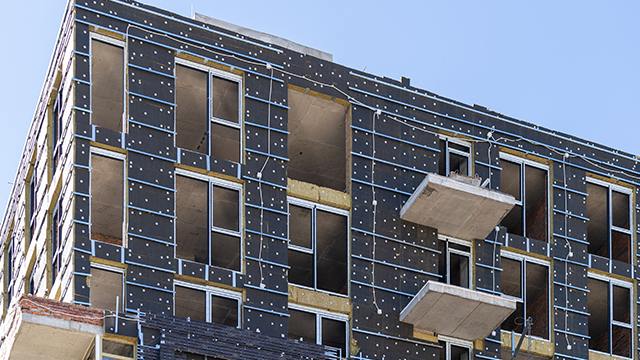Energy Tax Incentives Available for the Real Estate and Construction Industries
By Lisa Minniti-Soska | March 23, 2021
At the end of 2020, and after years of lobbying, the energy tax incentive industry secured several big wins. These came in the form of the §45L Residential Tax Credit receiving a one-year extension, extending the credit through the end of 2021, and the energy efficient commercial building tax deduction §179D being made permanent. Now, eligible parties in the real estate and construction industries can take advantage of these beneficial tax incentives and be rewarded with potentially significant savings. Below is more information on the credits and deductions, including eligibility and requirements for filing.
What is the 45L Tax Credit and How Does it Work?
The 45L tax credit is a credit equal to $2,000 per unit for qualified owner-occupied or rental dwelling units that meet certain energy-savings standards. In order to qualify for this tax credit, construction or rehabilitation of a unit must be substantially completed after August 8, 2005 and until sold or leased before the end of 2021. The tax credit is then claimed by the developer (known as the Eligible Contractor) in the year which the unit is occupied.
Qualifying properties consist of a dwelling unit or units, defined as one or more rooms including a kitchen and designed as a unit for occupancy by one family for the purpose of cooking, living and sleeping. In order to meet the requirements of Section 45L, a building must also be 3 stories or less above grade and may include apartments, condominiums, assisted living facilities, student housing dwelling units, townhouses, and single-family homes. The $2,000 tax credit is achieved for “each” dwelling unit within the building.
Each unit must meet a level of energy efficiency that is higher than 2006 IECC standards. Many newer or rehabbed developments already exceed these standards based on recent energy standards and building codes. As a result, to ensure that these important credits are not overlooked, it is recommended that any apartment or condominium project developed (new construction or rehabilitation) within the past four years to be evaluated for the 45L tax credit.
Who is the Eligible Contractor for 45L Tax Credits?
The 45L credit is available to an eligible contractor in the year the certified dwelling units are leased or sold. Previously, there was some confusion as to who qualifies as the eligible contractor with respect to the unit. For the purposes of 45L, a person or company must own and have basis in the qualified energy efficient unit during the construction to qualify as the eligible contractor with respect to the unit. For example, if an individual who hires a third-party contractor to construct the apartment or condo owns and has basis in the unit during its construction, the individual that hires the third-party contractor is the eligible contractor, and the third-party contractor is not the eligible contractor. As this can be tricky to decipher, consultation with a tax professional is always advised.
Certification Requirements for 45L Tax Credits
Once determined, the eligible contractor must obtain certification from an independent eligible certifier before claiming the energy tax credit with respect to the dwelling unit. An eligible certifier is a person not related to the eligible contractor that has been accredited or otherwise authorized by the Residential Energy Services Network (RESNET) or an equivalent rating network. The certifier conducts computer modeling and on-site testing and prepares a certification package with declaration that under penalties of perjury the certifier believes that the facts presented in the certification are true, correct, and complete. The fee for certification is typically charged on a per unit basis.
What is the 179D Tax Deduction and How Does it Work?
The newly permanent Section 179D provides for an immediate deduction claimed in the year in which eligible energy efficient property and building systems are placed in service and can vary based on both the size of the costs set by the American Society of Heating, Refrigerating and Air-Conditioning Engineers (ASHRAE) Standard 90.1-2001 (if placed in service prior to January 1, 2016) or Standard 90.1-2007 (for buildings placed in service on or after January 1, 2016). For purposes of the deduction, energy savings is measured in the following three categories:
- Interior lighting systems
- Heating, cooling, ventilation, and hot water systems
- Building envelopes (e.g., insulation, roofing, and windows)
Once it has been determined that a 50% savings in energy and power cost has been achieved, a tax deduction of up $1.80 per square foot can be applied. Additionally, partial deductions are available of up to $.60 per square foot per system for buildings where the overall building does not meet the 50% energy savings threshold, but individual building systems do meet certain requirements for energy savings. A partial deduction can still provide the taxpayer with substantial tax savings.
Below is an example of how the deduction works:
Assume a company builds a new 100,000 square foot warehouse that costs a total of $2,000,000. The new building includes property that has been certified to reduce energy usage by over 50% when compared to similar buildings. Under current depreciation rules, the building would be depreciated over 39 years, resulting in an annual deduction of $51,282.
However, under Section 179D, the taxpayer would be allowed to immediately expense $1.80 per square foot, or $1.80 X 100,000 = $180,000. The deduction would reduce the basis of the building, allowing a depreciation deduction in the current year of $46,667 (($2,000,000 – $180,000)/39 years). The maximum deduction for the building in the current year increases to the sum of $180,000 and $46,667, or $226,667.
Who is Eligible for 179D?
The deduction is available to building owners and lessees who make eligible improvements to a commercial building. These buildings can include warehouses, office buildings, retail buildings, industrial buildings and even apartment buildings, provided they are at least four stories or more. This means that most types of buildings located in the United States could potentially qualify for the deduction if the upgrades or installation of new building systems meet the energy efficiency requirements.
In addition, eligible designers, and builders (such as architects, engineers, contractors, environmental consultants, and energy service providers) of government owned buildings can also qualify for the 179D deduction under a special rule for public property. In this case, designers and builders that have enhanced the energy efficiency of a new government-owned building or made energy-saving renovations and renovations to existing government owned buildings are able to claim the deduction. As government entities do not traditionally pay tax, the owners of these buildings can allocate the deductions to the designer or builder responsible for the energy-saving enhancements. This is an attractive benefit to the building designer or builder since they receive a tax benefit without incurring any building construction costs. For businesses seeking a Section 179D deduction based on work performed on government-owned buildings, the company is required to secure an allocation letter that allows the government entity to transfer the benefit to the taxpayer.
Conclusion
The extension of 45L and the permanent tax deduction of 179D encourages green, energy efficient design of residential and commercial real estate. Poised to benefit from these enhanced tax credits are the architects, designers, builders and owners of these properties, and the potential tax savings can be significant. Speak to your real estate tax advisor to ensure that you take advantage of all potential tax credits available.
David Diaz, Managing Partner at Walker Reid Strategies, contributed to this article.
About Lisa Minniti-Soska

Lisa Minniti-Soska, CPA, is a Consultant at Marks Paneth LLP, serving general construction, construction management, homebuilders and specialty contractor clients. Ms. Minniti-Soska has more than 20 years of experience delivering expert accounting and auditing services, including tax preparation and planning, business consulting, forecasts and projections, capital and debt financing, and mergers and acquisitions support. Her other clients come from a variety of industries, with a focus on the real estate sector. Ms. Minniti-Soska received the... READ MORE +


